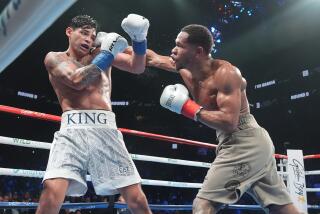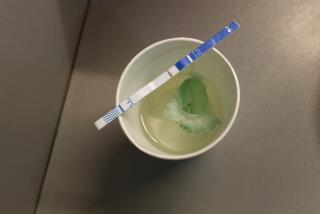Boxing Officials Exonerate Lora : By 4-3 Vote, Commission Rules Drug Tests Inconclusive
- Share via
SAN DIEGO — Bantamweight champion Miguel Lora was exonerated by a 4-3 vote of the California Athletic Commission Friday after a laboratory report indicated he tested positive for banned drugs shortly after a Forum championship bout.
A urine sample from Lora, a Colombian who won a one-sided unanimous decision over Albert Davila of Pomona to retain his World Boxing Council title Aug. 1, tested positive for amphetamines at the Central Diagnostic Laboratory in Tarzana on Aug. 4. But a second sample tested negative Aug. 11 at UCLA.
Four commission members Friday expressed reservations over the validity of both lab reports. And after 2 1/2 hours of testimony, commissioners Robert Wilson, Dr. Thomas Thaxter, chairman William Malkasian and Charles Westlund voted that Lora did not violate California Athletic Commission rule 309, which prohibits the use of drugs.
Commissioners Dr. P.B. Montemayor, Raoul Silva and Jerry Nathanson voted that he had violated the rule.
Thaxter, a Fresno orthopedist who called the lab-related testing testimony “tortuous,” seemed to speak for the three other commissioners who exonerated Lora when he said: “We’re told there’s a 5% false positive chance on the first lab test. How then can we say with certainty that he had drugs in his system that night?”
Lora was fined $1,000 on two lesser charges, for admittedly drinking sugar water during the fight, and for showing up late.
Lora was elated at the vote on the amphetamines charge.
Commission witness Dr. Mansfield Dean, pharmacy director at the Beverly Hills Medical Center, said the CDL test was a “basic screening test” that has a 5% chance of yielding a false positive result for amphetamines.
He said the more-sophisticated UCLA test, a gas chromatography mass spectrometry (GMS) test, showed no amphetamines but did show traces of phenylpropanolamine. That substance, he said, is found in numerous over-the-counter cold and flu medicines.
Dean cast a shadow over the UCLA test, also, when he told the commissioners that he was puzzled how phenylpropanolamine showed up in an 11-day-old urine sample.
“The literature on phenylpropanolamine says that can’t happen, that it should break down in a urine sample in just a few days.”
As to why amphetamines didn’t show up in the UCLA test, Dr. Robert Karns, a commission physician who was on duty at the Lora-Davila bout, said that was an expected result.
“By the time UCLA got it (the urine sample), you’d expect it to be negative,” he said. “The acidity and the bacteria in the urine would have destroyed it by then.”
Lora, testifying in Spanish through a translator, told the commission he’d taken a cold/flu medication called Reduxoson July 8 or 9, and denied emphatically he’d taken any illegal drug.
The urine samples were tested at different labs because World Boxing Council rules apply after a boxer’s first urine sample tests positive.
“The WBC takes over jurisdiction of the second sample, and in this case Jose Sulaiman (WBC president) asked us to take it to UCLA,” said Marty Denkin, assistant commission executive officer.
Ken Gray, commission executive officer, said after the meeting that California rules covering drug tests will be modified after the Lora case.
“Obviously, in retrospect, we wish we’d had both tests done at one place,” he said. “We’re going to talk to the WBC and try to prevent this kind of thing from happening again.”
Karns testified that he believed the first lab report, positive for amphetamines, was accurate.
More to Read
Go beyond the scoreboard
Get the latest on L.A.'s teams in the daily Sports Report newsletter.
You may occasionally receive promotional content from the Los Angeles Times.










